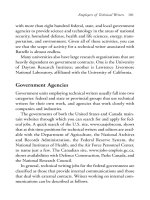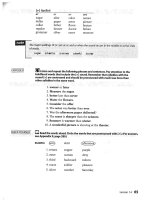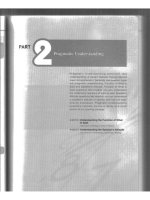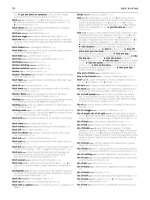Your writing coach part 12 potx
Bạn đang xem bản rút gọn của tài liệu. Xem và tải ngay bản đầy đủ của tài liệu tại đây (109.46 KB, 10 trang )
6 The hero encounters tests and helpers.
7 The hero reaches the innermost cave, a dangerous place. The
conflict is escalating with every step.
8 The hero endures the supreme ordeal, touches bottom, may
appear to die and be reborn.
9 The hero seizes the sword and takes possession of the treasure
he/she was seeking.
10 The road back, the chase—still some problems to overcome.
11 Resurrection—the hero emerges from the special world,
transformed.
12 The hero returns with the treasure, boon, or elixir to the ordi-
nary world and shares it.
If you happen to be a Star Wars fan, you probably know that
George Lucas used this as a template for those films, and you will
find it used in many books and films, especially action-adventure
stories. It’s not limited to those, of course, because the quest
could be a spiritual or intellectual one as well.
However, although this is a very useful guide, it’s designed to
be an inspiration, not a formula with which to fill in the blanks.
The story is the boss
The most important message I want to leave with you about
structure is this: Allow the story you want to tell to have its own
life and drive and to find its own shape. Everything you do
should be in service to the story you want to relate. If you find an
already established structure for telling it, that’s fine. If not, just
follow the story where it wants to go. If you are faithful to it, it
will not lead you astray.
102 Write!
KEY POINTS
✐ The premise is what your story is really about; the plot is the
sequence of events that you use to illustrate or prove the
premise.
✐ When our needs are denied by ourselves, by others, or by
nature, we fight back, and the more basic the need, the more
we fight. This principle supplies a story with the conflict it
requires.
✐ Writing in the first person establishes an emotional connec-
tion between the narrator and the reader, but limits the
action to what the narrator experiences.
✐ Writing in the limited third person is less intimate, but gives
the writer the freedom to get inside the heads of several
characters (with one viewpoint character per scene or
chapter).
✐ A subplot runs parallel to the main plot and can mirror it or
serve as a contrast.
✐ The fairy-tale story spine is an easy way to develop a rough
blueprint for the structure of the plot. The hero’s journey is
a more detailed structure.
✐ To hook the reader, a story should start with the inciting
incident, or at least foreshadow it.
✐ The Q/A technique keeps the story moving forward.
✐ The ending should stem from what has gone before. Ideally,
it is surprising yet logical.
✐ The structure should serve your premise and plot, not the
other way around.
EXERCISES
✐ For your three favorite films or novels, identify which of the
protagonist’s needs were threatened, and in what order. Do
you see a pattern?
Story Secrets 103
✐ In your own life, can you detect any conflict between what
you want and what a neutral observer might say you actually
need? If so, what kind of plot could come from this conflict?
✐ Try writing the same scene in the first person and then
again in the third-person limited-viewpoint mode. Which
do you prefer?
✐ Go to a bookshop or library and read the opening para-
graphs of ten novels you’ve never read before, and ten non-
fiction books. Which openings grab your attention? What
do they have in common? Which openings don’t? What do
they have in common?
CHAPTER BONUS
On the website www.yourwritingcoach.com, click on the
“Chapter Bonuses” tab, then the “Structure” tab, and type in the
code: structure. You will be taken to a video interview with
Robert Cochran, co-creator of the international hit television
series
24, talking about how to use story structure to create sus-
pense and heightened drama.
104 Write!
88
Watch Your Language
“Say all you have to say in the fewest possible words, or your
reader will be sure to skip them; and in the plainest possible
words or he will certainly misunderstand them.”
—John Ruskin
After working through the last chapter, you will have the build-
ing blocks of your structure. Now it’s time to make sure that your
words are worthy of your ideas, so in this chapter I’ll cover tech-
niques you can use to make your language come alive.
Come to your senses
You may have heard about NLP (neuro-linguistic programming)
in the context of business or psychology. It’s the study of how we
communicate not only with others but with ourselves as well,
using our mind/body (neuro) and language (linguistic) in pat-
terns that determine or at least influence our behavior (pro-
gramming). It was established in the late 1970s by Richard
Bandler and John Grinder, and now has many practitioners all
over the world.
One of the basic tenets of NLP is that individuals have their
own way of encoding their experience, using a combination of
their visual, auditory, kinesthetic, gustatory, and olfactory repre-
sentational systems. In other words, sight, sound, touch (and
feelings), taste, and smell. Often people unwittingly reveal which
system they depend on the most by the terminology they use. For
example, one person might say, “Yes, I see what you mean,”
another might say, “I hear what you’re saying,” another might say,
“Yeah, I have a good feeling about that,”another might say, “That
sounds like a sweet deal,” while another might say, “I think that
idea stinks!”
NLP suggests that one way to establish rapport with a per-
son is to figure out what his or her primary representation sys-
tem is, and use language that matches that system. Naturally,
you can’t know which system a reader prefers, so your strategy
has to be to make sure that most strategies, if not all, are repre-
sented in what you write, preferably quickly so that you hook
the reader. You should then continue to appeal to several senses
to make the reading experience compelling and involving for
all readers.
Let’s revisit Charles Dickens and the scene in
Great
Expectations
in which the narrator, Pip, is taken to a room in
Miss Havisham’s house. This time, notice how Dickens appeals
to various senses:
It was spacious, and I dare say had once been handsome,
but every discernible thing in it was covered with dust
and mould, and dropping to pieces. The most prominent
object was a long table with a tablecloth spread on it, as if
a feast had been in preparation when the house and the
clocks all stopped together. An epergne or centrepiece of
some kind was in the middle of this cloth; it was so heav-
ily overhung with cobwebs that its form was quite undis-
tinguishable; and, as I looked along the yellow expanse
out of which I remember its seeming to grow, like a black
fungus, I saw speckled-legged spiders with blotchy bod-
ies running home to it, and running out from it, as if some
circumstances of the greatest public importance had just
transpired in the spider community.
I heard the mice too, rattling behind the panels, as if
the same occurrence were important to their interests.
But, the blackbeetles took no notice of the agitation, and
groped about the hearth in a ponderous elderly way, as if
106 Write!
they were short-sighted and hard of hearing, and not on
terms with one another.
These crawling things had fascinated my attention
and I was watching them from a distance, when Miss
Havisham laid a hand upon my shoulder. In her other
hand she had a crutch-headed stick on which she leaned,
and she looked like the Witch of the place.
“This,” said she, pointing to the long table with her
stick, “is where I will be laid when I am dead. They shall
come and look at me here.”
With some vague misgiving that she might get upon
the table then and there and die at once, the complete
realization of the ghastly waxwork at the Fair, I shrank
under her touch.
“What do you think that is?” she asked me, again
pointing with her stick; “that, where those cobwebs are?”
“I can’t guess what it is, ma’am.”
“It’s a great cake. A bride-cake. Mine!”
There is a wealth of visual information, there are sounds like the
mice b
ehind the paneling, and there is touch, her hand on his
shoulder. Although Dickens doesn’t mention smells, I found
myself imagining a musty odor when he describes the mold, and
experienced a revulsion in my sense of taste when I pictured an
ancient wedding cake with bugs running in and out of it. It’s a
fine example of how descriptions from one representational sys-
tem can evoke responses in other representational systems.
Scriptwriters might object that for them, the kinesthetic,
olfactory, and gustatory present a bigger problem. Surely to indi-
cate anything that can’t actually be seen is breaking a cardinal
rule of scriptwriting? After all, the audience won’t be able to
touch, smell, or taste what’s on the screen. However, the first
audience for your script is not film goers, it’s the potential buy-
ers of the script. Your mission is to provide them with an excit-
ing reading experience that allows the movie to unfold in their
minds.
Watch Your Language 107
Let’s look at an example from the film world. Here’s the
opening of one of my favorite films,
Atlantic City, written by
John Guare, as published in the now-defunct
Scenario
magazine:
CLOSE-UP: A bright yellow lemon. A woman’s
hand takes a knife and slices it into quar-
ters. She flicks on a cassette player. Maria
Callas sings “Casta Diva” from Bellini’s
“Norma”. The camera pulls back to reveal
INT. SALLY’S APARTMENT – NIGHT
SALLY standing in front of a sink by an open
window. She is quite beautiful. She squeezes
the lemon juice into her palms and rubs the
juice on her shoulders and breasts and arms.
She washes herself carefully.
The camera pulls out of the window across the
air shaft into
INT. LOU’S APARTMENT – NIGHT
A man in his 60’s stands in his dark room
watching her. He smokes an unfiltered ciga-
rette. His name is LOU.
Guare writes like a novelist and does a few things for which the
typical screenwriting teacher would slap his hand: indicating
camera moves, specifying a particular piece of music, and put-
ting in details like the unfiltered cigarette that the audience prob-
ably would not notice. However, doesn’t it create a mood and get
us wondering who these people are? The visual is there with the
strong color of the lemon. Taste may have come into it, too, if
you thought about that juicy, sour lemon for a second. You may
even have imagined its smell. The opera music provides the
sound, and the juxtaposition of the two scenes creates a feeling
of unease in the viewer/reader—why is the older man watching
Sally? Is he a voyeur, or does he have a more sinister motive?
That’s all in less than a quarter of a script page.
108 Write!
As a writer, the way you create may also come, initially at
least, predominantly through one of the representational sys-
tems. The visual is probably the most common. Novelist and
screenwriter Joan Didion (Play It as It Lays, Close Up and
Personal
) told National Public Radio in the United States that she
always starts with a mental image. She writes to find out what’s
going on in that image. For her book
Run River, the picture was
of a house on a river in hot weather, a woman upstairs, a man
downstairs, and they weren’t talking to each other. For
Play It as
It Lays
, the picture was of a blonde girl in a white, halter-neck
dress being paged at 1 o’clock in the morning in a Las Vegas
casino. For
A Book of Common Prayer, it was of the Panama air-
port at 6 a.m., heat steaming up from the tarmac.
Other writers may find a starting point in something they
overhear, or a smell or taste that evokes certain memories
(remember Proust?).
Even the kinesthetic can be the starting point. In
Written By,
the journal of the Writers Guild of America, West, Alan Ball
recounted an incident that was part of the genesis of the film
American Beauty:
“I met a metaphysical bag outside the World Trade Center. I
was by myself and just walking to the subway stop, and this
bag just started moving around me, and I thought, well,
that’s weird. And it literally did it for ten minutes.
Depending on how you want to look at it, it was a coinci-
dence. But it was very striking, and it struck me. I was sort
of in that moment kind of overwhelmed with this immedi-
ate and completely unexpected emotional response because I
was a very jaded and cynical New Yorker. I just remember it
staying with me and feeling like I was in the presence of
something. And even as I say this to you right now, I under-
stand exactly how insane that sounds.”
To write more powerful books, stories, and scripts, it is useful to
pay attention to all your senses and to give an image, sound, or
Watch Your Language 109
other impulse time to form. These impulses don’t come up just
when you are sitting down to write. They show up, as Ball’s
example illustrates, at inconvenient times. It is easy to dismiss
them, especially when other people are present, or when you feel
you really should be thinking of something else. I find it useful to
think about such impulses again in the space between being awake
and going to sleep, or vice versa, at times when my mind is fluid.
If you are having trouble writing a scene, try switching to a
different representational system. If you can’t decide what the
characters should be saying to each other, for example, imagine
what each person is seeing, hearing, smelling, tasting, and feel-
ing. Do this for each character in the scene, and you may find
when you step back into the writer’s viewpoint, the scene has
fresh energy.
Life is in the details
Appealing to the various senses integrates well with another ele-
ment that makes writing come alive: vivid, interesting details.
Think ba
ck to the last time someone told you about their vaca-
tion. If they stuck to generalities, such as “We spent a lot of time
on the beach, it was very hot and we were pestered a bit by ven-
dors. One was selling religious things,” the description just
washes over you.
Compare that to someone who says, “The beach was swarm-
ing with vendors. One was a short black man who’d bleached his
hair blond, and he had a battered suitcase that he flipped open
with a flourish like a magician. And do you know what he was
selling? Crucifixes carved out of soap!” Now the scene comes
alive, you see the vendor, you imagine his movements, and you
can picture the objects he’s selling.
Many newer writers express themselves with language that’s
general and bland. Let’s face it, most people’s lives are general
and bland. They wake up, they put on the same kind of clothes
they put on yesterday, they have the same breakfast they had yes-
110 Write!
terday, they take the same route to work they took yesterday, and
they show up and do much the same kind of work they did yes-
terday. They don’t want that from their books or stories or
films—they want something different, vivid, interesting, excit-
ing. And they want it described in language that is vivid, interest-
ing, and exciting. Here’s an admittedly extreme example, from
journalist/novelist Tom Wolfe. This excerpt is from “The
Peppermint Lounge Revisited.” He describes some New Jersey
teenagers:
All right, girls, into your stretch nylon denims! You know
the ones—the ones that look like they were designed by
some leering, knuckle-rubbing old tailor with a case of
workbench back… Next, hoist up those bras, up to the
angle of a Nike missile launcher. Then get into the cable-
knit mohair sweaters, the ones that fluff out like a cat by
a project heating duct. And then unroll the rollers and
explode the hair a couple of feet up in the air into bouf-
fants, beehives, and Passaic pompadours.
Scrip
twriters are particularly guilty of writing bland descrip-
tions. Big mistake, as Tom Hanks points out:
“Reading a script is usually as exciting as reading a boiler-
plate legal document, so when you read one that makes you
feel as though you’re seeing the movie, you know it’s some-
thing different.”
Look for revealing actions
It’s not only in descriptions of the appearance of things that your
language makes a story come alive for the reader, it’s also in how
you describe the details of the characters’ actions. Talking about
his film
Daddy Nostalgia, writer and director Bernard Tavernier
pointed out:
Watch Your Language 111









